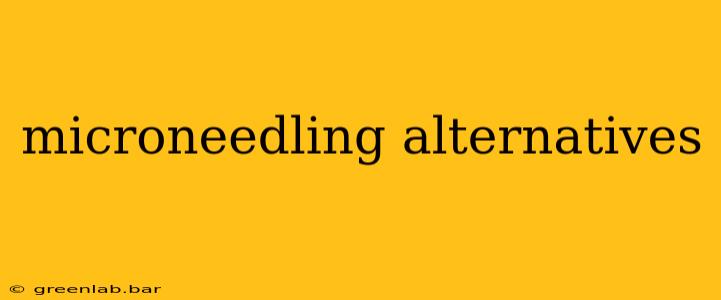Microneedling, while popular, isn't the only game in town when it comes to improving skin texture and tone. Many effective alternatives exist, each with its own set of benefits and drawbacks. Choosing the right method depends on your specific skin concerns, budget, and comfort level. This comprehensive guide explores various microneedling alternatives, helping you make an informed decision for your skincare journey.
Understanding Microneedling and its Goals
Before diving into alternatives, let's briefly revisit what microneedling aims to achieve. Microneedling, also known as collagen induction therapy, uses tiny needles to create controlled micro-injuries in the skin. This process stimulates collagen and elastin production, leading to improvements in:
- Skin texture: Reducing the appearance of scars, wrinkles, and fine lines.
- Skin tone: Minimizing pore size and improving skin evenness.
- Acne scars: Reducing the depth and visibility of acne scars.
Effective Microneedling Alternatives
Several treatments can deliver similar results to microneedling without the need for needles. Let's examine some of the most promising options:
1. Chemical Peels
Chemical peels use various acids (like glycolic, salicylic, or lactic acid) to exfoliate the skin's surface, removing dead skin cells and stimulating cell turnover. This process can improve skin texture, reduce acne breakouts, and minimize the appearance of fine lines and wrinkles. Different peel strengths cater to varying skin types and concerns. Note: Always consult a dermatologist to determine the appropriate peel strength for your skin.
2. Laser Treatments
Several laser treatments offer comparable benefits to microneedling. Fractional lasers, for instance, create microscopic columns of heat in the skin, triggering collagen production and skin rejuvenation. These treatments can address a wider range of concerns, including age spots, sun damage, and deeper wrinkles. However, laser treatments are typically more expensive than microneedling.
3. Dermabrasion
Dermabrasion is a more aggressive procedure that uses a rotating brush or other abrasive tool to remove the outer layers of skin. This technique is generally reserved for more severe scarring or skin irregularities. Recovery time is longer compared to microneedling and other alternatives.
4. Microdermabrasion
Microdermabrasion is a gentler, less invasive version of dermabrasion. It uses a specialized device to exfoliate the skin's surface, improving texture and tone. While less effective than dermabrasion for deep scars, it’s a good option for superficial concerns.
5. Radiofrequency Microneedling
This combines the benefits of microneedling with radiofrequency energy. The radiofrequency heats the deeper layers of the skin, stimulating collagen production even further than traditional microneedling. This can lead to more significant improvements in skin tightening and wrinkle reduction.
6. Topical Skincare Products
While not as potent as professional treatments, consistent use of high-quality skincare products containing retinol, vitamin C, and peptides can gradually improve skin texture and tone. These ingredients stimulate collagen production and cell turnover, albeit at a slower pace than the treatments mentioned above.
Choosing the Right Alternative
The best microneedling alternative for you depends on several factors:
- Severity of skin concerns: For mild concerns, topical treatments or microdermabrasion might suffice. More severe issues may require laser treatments or dermabrasion.
- Budget: Topical products are the most affordable option, while laser treatments are typically the most expensive.
- Downtime tolerance: Some treatments, like dermabrasion and certain laser treatments, involve significant downtime, while others, like microdermabrasion and chemical peels, require minimal recovery time.
- Skin type and sensitivity: Certain treatments are better suited to specific skin types. A dermatologist can help determine the most appropriate treatment for your individual skin.
Conclusion
Numerous effective microneedling alternatives exist, each with unique advantages and disadvantages. Consulting a dermatologist is crucial to determine the best approach for your specific needs and skin type. They can assess your skin's condition and recommend the most appropriate treatment to achieve your desired results safely and effectively. Remember that consistent skincare practices, regardless of the treatment chosen, contribute significantly to healthy, radiant skin.

